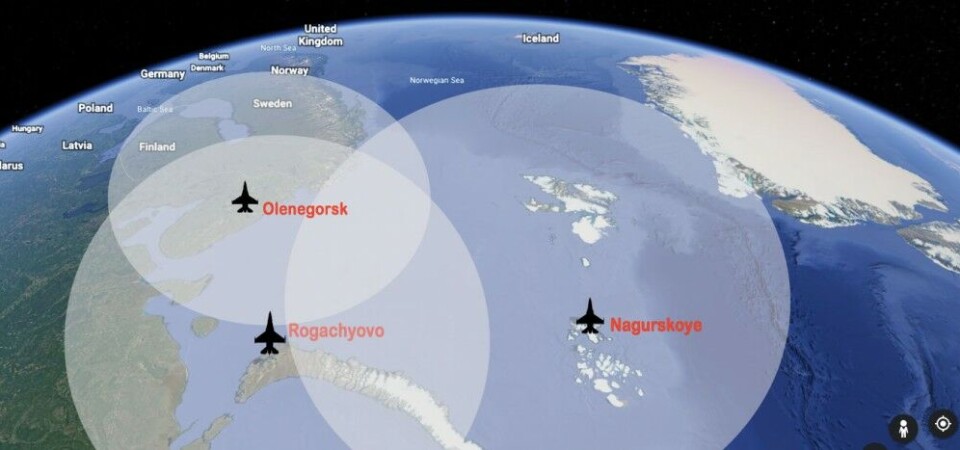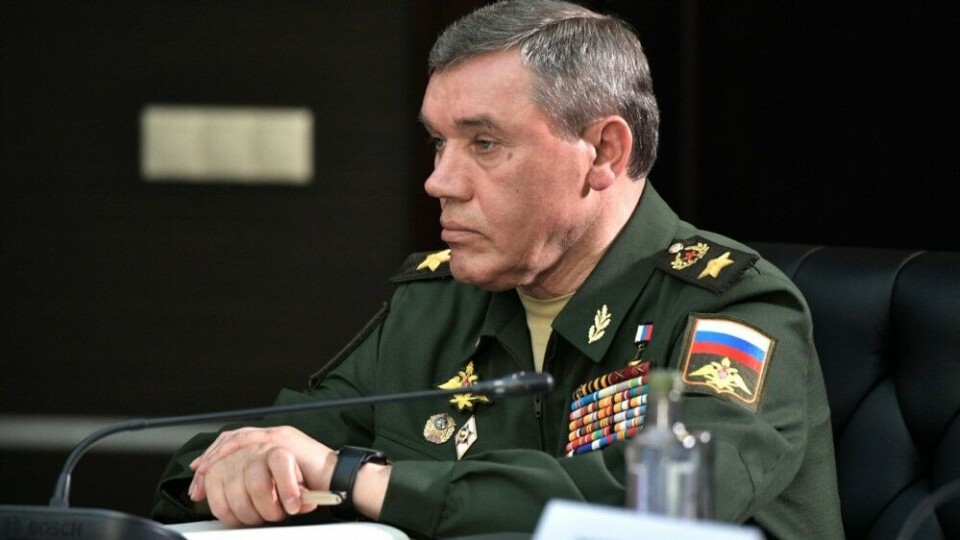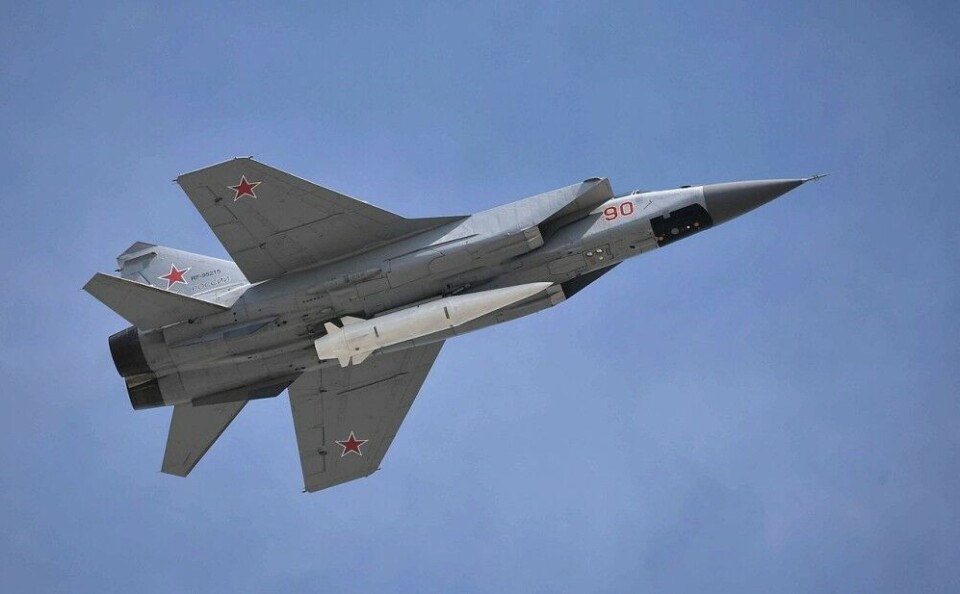
Russia’s top General indirectly confirms Arctic deployment of the unstoppable Kinzhal missile
MiG-31K fighter jets armed with the new Kinzhal air-launched ballistic missile based at Kola, Franz Josef Land and Novaya Zemlya could in practice pose a threat it is not possible to defend against in the European Arctic, northern Scandinavia and North-Atlantic.
It was on Tuesday Russia’s Chief of the General Staff of the Armed Forces, Valery Gerasimov, hosted 150 military attaches from the diplomatic missions of 70 countries in Moscow.
General Gerasimov presented his country’s military strategies, new weapons systems and views on other nations military behavior in regards to international arms treaties, in particular the United States.
Not surprisingly, the different legs of Russia’s nuclear weapons were given special attention.

General Gerasimov expressed concern about the future of the New START Treaty that expires in 2021, before he went on talking about the new strategic nuclear weapons under development in Russia.
“The Kinzhal aviation missile system with a hypersonic missile is on experimental combat duty. These missiles were launched at training grounds in various climate conditions, including in the Arctic,” the General said.
His keynotes for the speech are published on the portal of the Ministry of Defense, in both Russian and English. There is, though, a difference in the two language versions. While the English version is shortened, the Russian version includes the extra sentence said by Gerasimov to the audience of military attachés:
“At the same time, a network of airports is under development, providing an expansion of the geography of the use of this [missile] complex.”
Although the General did not name the airports, it is well known that Russia is expanding existing and building new runways at five locations in the High Arctic; Rogachyovo at the southern island of Novaya Zemlya, Nagurskoye on the Aleksandra lsland at Franz Josef Land, Sredniy at Severnaya Zemlya, Kotelny at the New Siberia Islands and Wrangel Island north of the Kamchatka Peninsula.
In the European Arctic, both the new runways at Nagurskoye and Rogachyovo have been announced to facilitate for MiG-31 and other military aircraft like tankers and bombers.
The new runway at Nagurskoye on Franz Josef Land is some 3 kilometers west of the older and next to the new military Trefoil base complex.
What Gerasimov said was an indirect confirmation of Russia deploying the Kinzhal missile on aircraft at Franz Josef Land, a move that could change the military power-balance in the strategically important North-Atlantic.
The new missile was first time tested in Arctic conditions in mid-November, as previously reported by the Barents Observer. Launched from a MiG-31K with take-off from Olenegorsk airfield on the Kola Peninsula, the missile reportedly made a successful ballistic path and hit its target at the Pemboy range, some 60 kilometers from Vorkuta near the Ural Mountains.
With Kinzhal, Russia in many ways get a military supremacy in the European Arctic, from Greenland in the west to northern Scandinavia in the east.
This is the core of the so-called Bastion defense concept, aimed at protecting the Russian Northern Fleet’s nuke-submarines in the Barents Sea by expanding control and conducting sea- and air denial operations in the maritime space all the way south to the Greenland-Iceland-UK (GIUK) gap in case of an escalating military conflict.

In principle, the Kinzhal missile is an air-carried version of the Iskander land-based short-range ballistic missile. That said, placing such missile on an aircraft gives it a more dangerous strategic position.
First, the missile could be launched from unpredictable locations because an aircraft moves much faster than a land-based vehicle. Secondly, an aircraft adds extra range before the missile itself is launched.
Unlike cruise missiles launched from an aircraft, the Kinzhal goes ballistic. Like other ballistic missiles launched from silos or submarines, going ballistic via space means hypersonic speed.
The November-test over the Barents Sea was said to reach a speed of 10 Mach, ten times the speed of sound. With terrifying accuracy and short alert time, Kinzhal is changing the thinking of traditional nature of warfare in the high north.
There is practically no way to stop the missile which warhead can be both conventional or nuclear.
There are different estimates in regards to the range of Kinzhal. Given the launch of the missile from the MiG-31K in November happened in the Barents Sea north of the Kola Peninsula, the distance to impact at the Pemboy range was about 1,000 km.
TASS, a state own news agency known for exaggerating Russian military characteristics, says the range to be 2,000 kilometres. One story by TASS claims the range of Kinzhal to reach about 3,000 km if aboard the new Tu-22M3 bomber.
Wikipedia says the MiG-31K has a combat range when flying at Mach 2,8 of about 400 km. The Iskander-M ground-based missile has a range of 500 km. If we take that as a minimum range of Kinzhal, the missile’s target destruction range will be equal to at least 1,000 km, maybe more. The top-map illustration in this article shows the range of 1,000 km from the three airports in the European Arctic.
For Nordic neighbors, the Kinzhal missile poses a totally new military challenge. In distance from Monchegorsk air base where the MiG-31s are based or the nearby Olenegorsk air base where the Tu-22Ms are based south of Murmansk, Norway’s Bodø air base is 800 km away and within range with good margins.
Bodø is the main airport for Norway’s fleet of F-16 fighter jets. Ørland air base west of Trondheim, where Norway’s new fleet of F-35 Joint Strike Fighters is located is 1,200 km in distance from Olenegorsk and Monchegorsk air bases at the Kola Peninsula.
Kallax air base in Luleå, northern Sweden, is about 570 km from Olenegorsk and Monchegorsk air bases, while Rovaniemi air base in Finnish Lapland is about 370 km away. Also Satakunta Air Command at Tampere in southern Finland is within range, located 880 km from the two air bases on Russia’s Kola Peninsula.
When deployed at Franz Josef Land, the Kinzhal has a target range that covers all of Svalbard, the waters between Svalbard, Greenland and western Finnmark region in Norway.
We hope you found this article interesting. Unlike many others, the Barents Observer has no paywall. We want to keep our journalism open to everyone, including to our Russian readers. The Independent Barents Observer is a journalist-owned newspaper. It takes a lot of hard work and money to produce. But, we strongly believe our bilingual reporting makes a difference in the north. We therefore got a small favor to ask; make a small donation to our work.
















